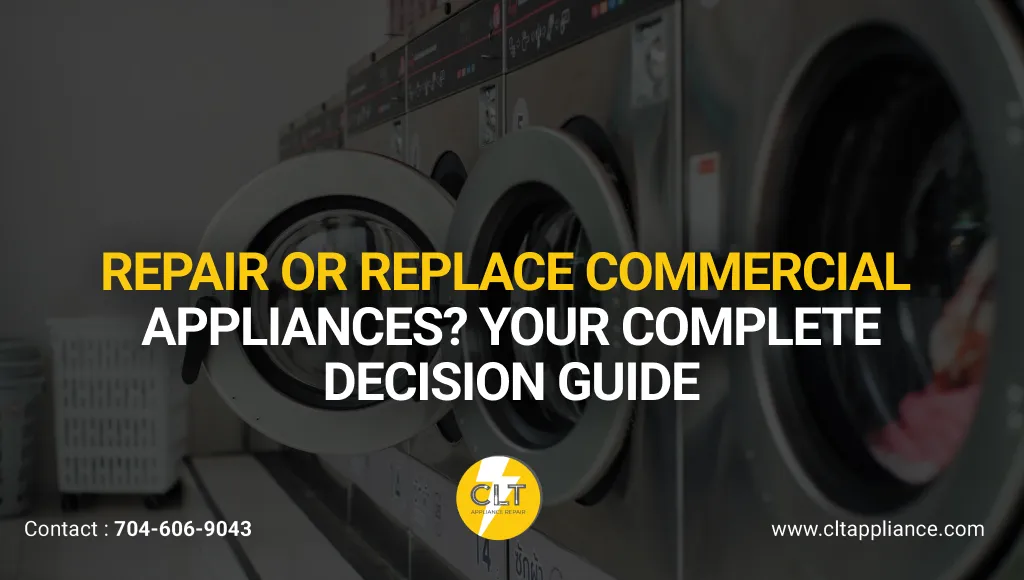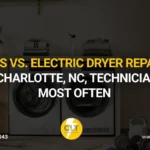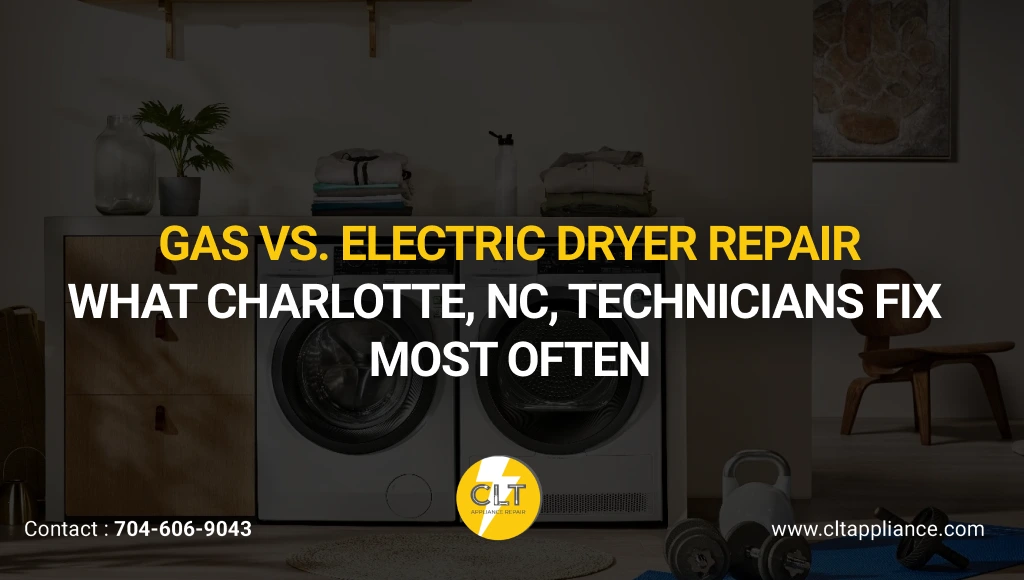[TL;DR]
Making the right choice between repairing and replacing commercial appliances can save thousands in operational costs. Commercial Repair Appliances: When they’re under 5 years old, repair costs are under 50% of replacement value, and parts are readily available. Replace when frequent breakdowns occur, energy efficiency drops significantly, or safety concerns arise. Key decision factors include appliance age, repair frequency, energy consumption, and operational impact. Regular maintenance extends equipment life by 30-40%, while most commercial appliances last 8-15 years with proper care. Smart businesses analyze total costs, including downtime, energy savings, and reliability improvements, rather than focusing solely on immediate repair expenses.
Your walk-in freezer starts making strange noises at 2 AM, threatening substantial inventory loss. Your dishwasher breaks during the dinner rush, leaving servers scrambling. Equipment failures like these contribute to significant annual losses from unplanned downtime. When every hour counts, choosing between repair and replacement becomes critical to avoid lost revenue.
Repair Commercial Appliances decisions directly impact your bottom line, operational efficiency, and customer satisfaction. Industry data reveals that commercial kitchens consume 2.5 times more energy per square foot than other commercial spaces, making energy-efficient equipment decisions crucial for operational costs.
Smart business owners who consider energy savings, reliability, and disruptions make better financial decisions than those opting for quick fixes. The right analysis protects investments and ensures smooth, profitable operations.
Our certified technicians assess your equipment condition and provide transparent cost comparisons between repair and replacement options.
[Schedule Equipment Assessment: 704-606-9043]
Why Does the Commercial Appliance Repair vs. Replace Decision Matter?
The repair versus replacement choice directly impacts your bottom line and operational efficiency because wrong decisions can cost businesses thousands in unnecessary expenses or lost revenue. Poor equipment choices affect multiple business areas simultaneously.
-
Financial Impact on Business Operations
Cost implications hit businesses immediately. Repair costs can vary significantly for most commercial appliances, while replacements require major investment, depending on the equipment type.
-
Operational Efficiency and Productivity Loss
Productivity suffers when equipment fails repeatedly. Broken refrigerators spoil inventory. Faulty ovens delay orders. Unreliable dishwashers and slow service. Each breakdown costs money through lost sales and customer dissatisfaction.
- Environmental Considerations for Sustainable Business
Environmental impact matters for sustainable operations. Repairing extends equipment life and reduces waste. However, old inefficient appliances consume more energy and increase carbon footprints.
Common Types of Commercial Appliances
Commercial operations rely on various appliances that require different decision-making approaches. Understanding typical lifespans helps guide repair versus replacement choices.
Essential kitchen equipment includes:
- Refrigerators and freezers (10-15 year lifespan)
- Ovens, stoves, and ranges (8-12 year lifespan)
- Dishwashers and ice machines (7-10 year lifespan)
- Laundry equipment for hotels and healthcare (10-14 year lifespan)
Each appliance type has unique maintenance needs and failure patterns that influence decision-making.
When to Repair Commercial Appliances
Factors Favoring Repair
Equipment Age: Age matters most in repair decisions. Appliances under 5 years old usually benefit from repairs unless catastrophic damage occurs. Equipment within its expected lifespan often has many productive years remaining.
- Cost Analysis: Repair costs under 50% of replacement value make financial sense. If reasonable repair costs can fix expensive equipment, the repair saves money immediately. Calculate total repair costs including labor, parts, and service calls.
- Issue Severity: Minor issues respond well to repairs. Broken handles, faulty thermostats, or worn gaskets represent simple fixes. These problems don’t indicate systemic failures.
- Parts Availability: Parts availability ensures successful repairs. Common appliances from major manufacturers maintain good parts support. Check parts availability before committing to repairs.
- Warranty Status: Warranty coverage reduces repair costs significantly. Equipment under warranty often receives free repairs or discounted service. Review warranty terms before paying for repairs.
Benefits of Repairing
Repairing commercial appliances offers several immediate advantages over replacement. These benefits make repairs attractive for newer equipment with minor issues.
Financial and operational benefits:
- Lower immediate costs preserve working capital
- Less operational disruption maintains normal business flow
- Extended equipment life maximizes original investment
- Faster resolution gets the equipment back online quickly
Professional repairs ensure optimal performance and prevent recurring issues. Repair Commercial Appliances with qualified technicians to maintain efficiency and safety standards. 45% of consumers prefer repairing their devices rather than replacing them, driven by cost and environmental concerns.
Emergency repair services from CLT Appliance Repair restore your equipment within hours, preventing extended downtime and protecting your revenue stream during critical situations.
[Get Emergency Service: 704-606-9043]
When to Replace Commercial Appliances
Signs Replacement Is the Better Option
Key indicators that signal replacement time:
- Frequent repairs: Monthly service calls or repair costs exceeding 50% of replacement value
- Age and inefficiency: Appliances over 10 years old with high energy consumption and breakdowns
- Operational disruption: Equipment failures during peak hours affect customer satisfaction
- Safety concerns: Electrical problems, gas leaks, or temperature control failures
- Unavailable parts: Discontinued models or obsolete components preventing effective repairs
Benefits of Replacement
Modern commercial appliances deliver significant advantages that often justify replacement costs. These improvements impact both operational efficiency and long-term profitability.
Improved energy efficiency reduces utility costs by 20-30%. Modern appliances use advanced technology to minimize energy consumption. Energy savings often offset replacement costs within 3-5 years.
Key replacement advantages:
- Enhanced performance and reliability prevent unexpected breakdowns
- Access to new features and technology improves operations
- Reduced maintenance costs eliminate frequent service calls
- Manufacturer warranties provide peace of mind
Modern appliances use advanced technology to minimize energy consumption. Energy savings often offset replacement costs within 3-5 years. The trend toward smart appliances is growing, with 17% of households in the U.S. owning smart appliances as of 2023, which offer enhanced energy efficiency and monitoring capabilities.
Key Considerations in the Decision
Cost Analysis: Repair vs. Replacement
Smart cost analysis considers multiple factors beyond initial repair estimates:
- Total Repair Costs:
Calculate total repair costs, including parts, labor, and service calls. Factor in lost productivity during repair time and potential recurring issues.
- Long-term Investment Comparison:
Compare repair costs to replacement investment over time. Include energy savings, maintenance costs, and reliability improvements in calculations.
- Downtime Impact Assessment:
Consider operational downtime costs. Calculate lost revenue during equipment failures and emergency repairs.
- Tax Benefits and Depreciation:
Factor in tax benefits and depreciation. New equipment purchases may qualify for tax deductions or accelerated depreciation schedules.
Performance Analytics: usinesses using comprehensive cost analysis save significantly more on equipment decisions compared to those making quick repair-replace choices
Appliance Age and Expected Lifespan
Understanding typical equipment lifespans guides decision-making and helps predict replacement timing. Manufacturer recommendations provide baseline expectations for equipment planning.
Typical commercial appliance lifespans:
- Commercial refrigerators and freezers: 10-15 years
- Ovens and ranges: 8-12 years, depending on usage intensity
- Dishwashers: 7-10 years with regular cleaning and maintenance
- Ice machines: 6-10 years with proper water filtration
- Laundry equipment: 10-14 years with preventive maintenance
Check equipment manuals for specific lifespan estimates and maintenance requirements that can extend operational life.
Availability of Parts and Service
Parts availability determines repair feasibility. Contact manufacturers or authorized dealers to verify parts availability before deciding on repairs.
Service contract coverage affects repair decisions. Comprehensive service agreements may favor repairs over replacements during contract periods.
Genuine parts ensure proper performance and safety. Avoid aftermarket parts that may compromise equipment reliability or void warranties.
Comprehensive service contracts include preventive maintenance, priority repairs, and genuine parts to maximize your equipment’s lifespan and minimize unexpected costs.
[View Service Options: 704-606-9043]
Maintenance and Prevention
Importance of Regular Maintenance
Proactive maintenance extends appliance life by 30-40%. Regular cleaning, inspections, and component replacements prevent major breakdowns and costly repairs. Scheduled maintenance reduces emergency repairs by 60% through early problem identification.
Recommended maintenance schedules:
- Daily cleaning and operational checks
- Weekly deep cleaning and calibration
- Monthly component inspections and replacements
- Quarterly professional service and safety checks
- Annual comprehensive overhauls and warranty inspections
Preventive care identifies problems before they cause equipment failure, saving thousands in emergency repairs.
Warning Signs to Watch For
In 2019, the average repair rate of appliances in case of a breakdown stood at 54%, highlighting the importance of preventive care over reactive repairs.
- Breakdown Patterns
Recurring breakdowns indicate underlying problems requiring attention. Document failure patterns and repair frequency.
- Performance Issues
Unusual noises, leaks, or performance drops signal developing issues. Address these symptoms promptly to prevent major failures.
- Energy Efficiency
Increased energy consumption suggests declining efficiency. Monitor utility bills and equipment performance regularly.
- Temperature Control
Temperature fluctuations in refrigeration equipment threaten food safety. Replace temperature-sensitive appliances showing inconsistent performance.
Steps to Take When Deciding
Follow this systematic approach for equipment decisions:
- Assess age and condition: Review purchase date, maintenance records, and performance levels
- Calculate total costs: Include repair expenses, replacement investment, and long-term implications
- Evaluate operational impact: Consider how failures affect business operations and customer service
- Check warranty and parts: Verify coverage and ensure replacement parts remain available
- Consult qualified technicians: Get a professional diagnosis with accurate estimates and recommendations
- Document decisions: Record outcomes to improve future equipment choices and budget planning
Final Call
Making informed decisions about commercial appliance repair versus replacement requires careful evaluation of costs, equipment age, operational impact, and long-term benefits. Smart business owners balance immediate expenses against future savings and reliability improvements. Regular maintenance extends equipment life and delays replacement needs, while timely replacements prevent costly breakdowns and improve efficiency.
Professional guidance ensures optimal decisions that protect your investment and maintain business operations. Repair Commercial Appliances when it makes financial sense, but don’t hesitate to replace when repairs become uneconomical or safety concerns arise.
CLT Appliance Repair brings 15+ years of experience helping businesses make smart equipment decisions. Our certified technicians provide honest assessments, transparent pricing, and guaranteed workmanship on all repairs and installations.
If you need emergency repairs, routine maintenance, or replacement consultation, we deliver solutions that keep your business running smoothly. From restaurants to hotels, we understand how equipment failures impact your operations and bottom line.
Call CLT Appliance Repair today for expert service you can trust. Your equipment. Our expertise. Better business results.
[Contact CLT Appliance Repair Now: 704-606-9043]
Frequently Asked Questions
How Do I decide whether to repair or replace a commercial appliance?
Compare repair costs to replacement costs; if repairs exceed 50% of the replacement price or the equipment nears end-of-life, replacement typically offers better value and reliability.
What are the signs that a commercial appliance should be replaced instead of repaired?
Frequent breakdowns, rising repair costs, safety concerns, outdated technology, or unavailable parts indicate replacement needs over continued repair attempts
Are repairs for commercial appliances usually cost-effective?
Repairs prove cost-effective for newer appliances with minor issues, especially when parts remain available and equipment operates within expected service life.
Will replacing an old appliance save on energy and operational costs?
Yes, newer commercial appliances typically offer 20-30% better energy efficiency, reducing utility bills and maintenance costs over their operational lifetime.
How long do most commercial kitchen appliances last?
Most commercial appliances last 8-15 years with proper maintenance; refrigerators last 10-15 years, ovens 8-12 years, and dishwashers 7-10 years.
What are the most common problems with commercial appliances that require repair?
Common issues include temperature control failures, mechanical wear, electrical problems, and seal deterioration, all disrupting operations if not addressed promptly.
Author

- John Bennett
- John Bennett is a seasoned appliance repair specialist at CLT Appliance Repair, where he brings over a decade of technical expertise and a strong commitment to customer satisfaction. With a background in electrical and mechanical systems, John has built a reputation for reliable, efficient, and honest repair services across a wide range of household appliances-including refrigerators, washing machines, ovens, and more.
Latest entries
News11/19/2025Why Your Dryer Smells Burnt: Common Causes & Fixes in Charlotte, NC
News11/19/2025Preventive Maintenance Tips to Extend Your Dryer’s Life in Charlotte
News11/18/2025Gas vs. Electric Dryer Repair: What Charlotte, NC, Technicians Fix Most Often
News11/18/2025Top 5 Signs Your Dryer Needs Professional Repair in Charlotte, NC









